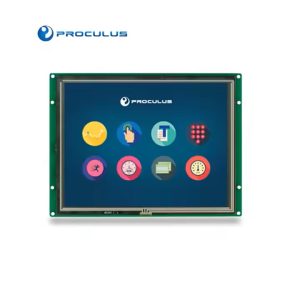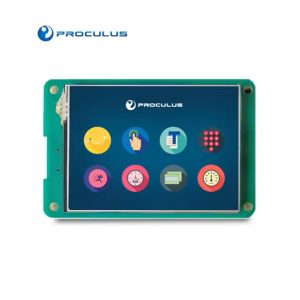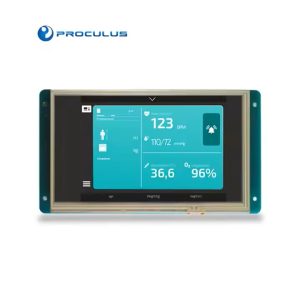Capacitive touch vs resistive touch: differences & how to choose
Touchscreen technology has revolutionized how we interact with devices, from smartphones and tablets to industrial control panels.
When selecting a touchscreen for your project, it’s essential to choose the right technology to ensure optimal performance, durability, and user experience.
The two most common types, capacitive and resistive, offer distinct advantages depending on the application.
This guide will help you understand how they work, their strengths and limitations, and which one is best suited for your needs.
 Resistive touchscreen technology has remained a popular choice in industries where durability, affordability, and compatibility with different input methods are essential.
However, it comes with certain trade-offs when compared to capacitive touchscreens.
Resistive touchscreen technology has remained a popular choice in industries where durability, affordability, and compatibility with different input methods are essential.
However, it comes with certain trade-offs when compared to capacitive touchscreens.
What is capacitive touch and how does it work?
Capacitive touchscreens use a transparent conductive layer, typically made of indium tin oxide (ITO), placed over a glass substrate. This layer forms an electrostatic field, and when a conductive object, such as a human finger, comes into contact with the screen, it alters the field at that specific location. Sensors detect these changes and translate them into precise touch inputs. Unlike resistive touchscreens, capacitive touchscreens do not rely on physical pressure. Instead, they detect the conductive properties of the user’s touch, making interactions smooth and highly responsive. They also support multi-touch gestures, such as pinch-to-zoom and swiping, which are essential for modern user interfaces.Pros and cons of capacitive touch
Understanding the pros and cons will help you determine whether capacitive touch is the right choice for your project or if a resistive touchscreen might be more suitable.Pros of capacitive touch
Understand the pros of capacitive touch here:- Superior touch sensitivity: Capacitive screens are extremely responsive and support multi-touch gestures, allowing for a smooth, intuitive user experience;
- High clarity and brightness: Since capacitive screens are made with a single glass layer and do not require additional protective coatings, they offer excellent optical clarity and vibrant colors;
- Durability and longevity: With a glass-based surface, capacitive screens are highly resistant to scratches and general wear and tear, making them a reliable long-term solution;
- Seamless integration with modern devices: Thanks to its sleek and modern design, capacitive touch is the standard for high-end consumer electronics, such as smartphones, tablets, and smart displays.
Cons of capacitive touch
Understand the cons of capacitive touch here:- Limited input compatibility: Standard capacitive screens do not respond to non-conductive materials, such as regular gloves or plastic styluses, unless a specialized capacitive stylus is used;
- Higher Cost: Due to their advanced technology and materials, capacitive touchscreens are generally more expensive than resistive options;
- Less Effective in Harsh Environments: High moisture levels, heavy rain, or the use of gloves can interfere with capacitive touch functionality, making it less suitable for rugged industrial or outdoor applications.
What is resistive touch and how does it work?
Resistive touchscreens operate using a pressure-sensitive mechanism composed of multiple layers. The two primary layers, a flexible, transparent top layer and a rigid bottom layer, are coated with a conductive material, typically indium tin oxide (ITO). These layers are separated by tiny insulating dots called spacers. When pressure is applied to the screen, such as from a finger, stylus, or any object, the two layers make contact, creating a change in electrical current that registers as a touch event. This simple yet effective design allows resistive touchscreens to function reliably in various environments, making them a preferred choice for industrial, medical, and outdoor applications. Compared to capacitive touchscreens, resistive displays are generally more cost-effective and versatile in terms of input methods. However, they sacrifice some clarity and responsiveness due to their multi-layered structure and pressure-based activation.Pros and cons of resistive touch
 Resistive touchscreen technology has remained a popular choice in industries where durability, affordability, and compatibility with different input methods are essential.
However, it comes with certain trade-offs when compared to capacitive touchscreens.
Resistive touchscreen technology has remained a popular choice in industries where durability, affordability, and compatibility with different input methods are essential.
However, it comes with certain trade-offs when compared to capacitive touchscreens.
Pros of resistive touch
Understand the pros of resistive touch here:- Versatile input methods: A major advantage of resistive touch technology is its ability to work with almost any input method. The screen will register the touch whether you’re using a stylus, a gloved hand, or even a non-conductive object like a pen cap. This makes resistive touchscreens ideal for applications where users may not always have direct finger contact, such as in medical environments, outdoor kiosks, or industrial settings;
- Lower cost: Compared to capacitive touchscreens, resistive screens are more budget-friendly. Their simpler manufacturing process and widespread adoption make them a cost-effective choice for applications where affordability is a priority without sacrificing functionality;
- Durability in harsh environments: Resistive touchscreens are highly resistant to dust, moisture, and extreme temperatures. Resistive displays function reliably in rugged conditions, unlike capacitive screens which may struggle in wet or outdoor environments, making them a preferred option for industrial machinery, outdoor ATMs, and military applications;
- Precise touch control: Since resistive touchscreens register pressure rather than electrical conductivity, they offer pinpoint accuracy. This makes them ideal for applications that require precise input, such as signature capture, point-of-sale (POS) systems, and medical diagnostic devices.
Cons of resistive touch
Understand the cons of resistive touch here:- Limited multi-touch capability: Resistive screens typically recognize only one point of contact at a time, unlike capacitive touchscreens, which support gestures like pinch-to-zoom and multi-finger swipes. This can be a limitation for applications that require advanced touchscreen interactions;
- Lower display clarity: Due to the multiple layers in resistive touchscreen construction, light transmission is slightly reduced compared to capacitive displays. This can result in a dimmer or less vibrant screen, which may require additional backlighting to maintain visibility, particularly in bright environments;
- Increased wear and tear: Since resistive screens rely on physical pressure, they are more prone to wear over time. Repeated use can cause the top layer to degrade, leading to calibration issues or reduced touch sensitivity. This makes them less ideal for high-traffic consumer electronics where long-term durability is essential;
- Slower response time: While resistive screens are effective for many applications, their response time is generally slower compared to capacitive touchscreens. Users may notice a slight delay between touch input and on-screen action, which could impact user experience in fast-paced or interactive applications.
Capacitive touch vs. resistive touch: which one to choose for your project?
Selecting the right touchscreen technology depends on various factors, including user experience, environmental conditions, and budget. You should choose capacitive touch if:- You need a highly responsive, multi-touch display;
- Clarity and visual quality are a priority;
- You want a long-lasting, low-maintenance solution;
- Your application is in a controlled environment.
- You require compatibility with multiple input methods;
- You need a cost-effective solution;
- Your device will be used in extreme environments;
- You prioritize durability over aesthetics.
Find the right touchscreen solution for your project
Capacitive and resistive touchscreens each offer unique advantages, and the best choice depends on your specific project needs. Capacitive screens deliver high responsiveness, multi-touch capabilities, and superior clarity. They are ideal for modern, interactive applications. In contrast, resistive touch technology provides cost-effective durability and versatility, making it the preferred option for rugged industrial environments and specialized input requirements. At Proculus Technologies, we specialize in advanced UART TFT LCD modules designed for effortless integration and optimal user experience. Whether you’re developing a consumer-grade product or an industrial device, our modules offer a perfect balance of performance, efficiency, and ease of use. Explore our UART TFT LCD modules to find the ideal touchscreen solution for your next project.
Category:
Author:
Client:
Date:
PHP Code Snippets Powered By : XYZScripts.com
 English
English


